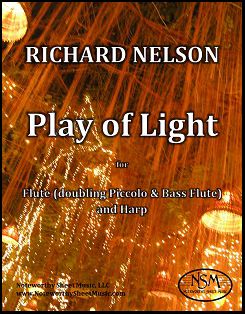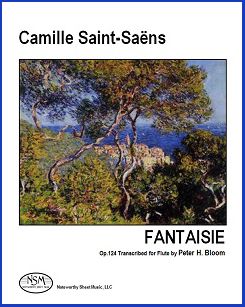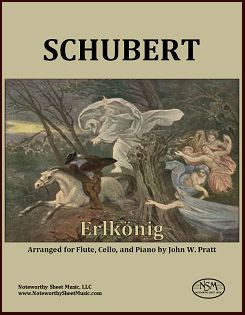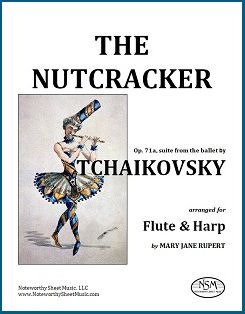Flute w/Mixed Ensembles
Nelson - Play of Light - Flute & Harp
 Play of Light, by Richard Nelson
Play of Light, by Richard Nelson
Contemporary Composition for Flute (doubling piccolo & bass flute) and Harp
Score and Flute Part, PDF $15.25
Play of Light, for flute and harp, was written for the duo "2" (Peter H. Bloom and Mary Jane Rupert). The piece is built around spaciousness, transparency, multi-hued shadings and playful chases. The incorporation of bass flute and piccolo further enhances the inherently rich color possibilities of the flute/harp combination—the three flute instruments in succession form a sort of "super-flute" in the work's final section.
Drawing on his jazz and improvisation background, composer Richard Nelson in this composition leads the players into a substantial section that they complete through improvisation. While they follow signposts on intensity, energy and pitch content that he provides, this practice nonetheless creates an element of intrigue and unpredictability that the composer values highly. It also assures that each performance of the piece will have a strongly individual profile.
The Duo "2" artists have released a studio recording of Play of Light, available free of charge; please click the link to listen to the audio file on the composer's SoundCloud site.
Peter H. Bloom gave a lecture on “Effective Writing for Flutes and the Contemporary Flutist” at the 2018 Snow Pond Composers Workshop. In his presentation, Mr. Bloom discussed various topics using four contemporary works published by Noteworthy Sheet Music, including Play of Light, as examples. We later published a free text version of this excellent presentation on our website, in the Reviews and Articles section, including some of the audio clips and supplemental written materials that Mr. Bloom used as demonstrations.
Score, 23 pages; Flute part, 9 pages; Total, 36 pages.
Preview==========================================================
We also offer a print version of Play of Light by Richard Nelson, for those who prefer to purchase the work as a professionally-printed hard copy. Due to prohibitively high international shipping rates, we ship print editions only to addresses in the USA. The cost of the hard copy edition of Play of Light is $25.93, plus a $5.95 shipping and handling fee. Please use the Contact Us form to let us know which print publication(s) you would like to purchase, along with your email contact information and USPS mailing address. We will then send you a PayPal invoice for the sale and, once we receive notice from PayPal that you have paid for the item(s), we will ship your music to the address provided for delivery in 7-10 business days.
Saint-Saëns - Fantaisie - Flute
 Fantaisie, Op.124, by Camille Saint-Saëns
Fantaisie, Op.124, by Camille Saint-Saëns
Transcribed for Flute (originally for violin) by Peter H. Bloom
Flute Part, PDF $8.98
The following excerpt is taken from Peter H. Bloom's foreword to the edition:
"We flutists are always on the lookout for great repertoire to perform with harp, and the Fantaisie is a perfect gem to purloin from the violinists' repertoire. The expressively romantic melodies, lush impressionistic sonorities, athletic intervals, diversity of articulation, variety of dynamics, and evocative exoticism are ideal for the flute. The few problems of range are easily modified, customized, accommodated. As a duo, the work features both instruments in equally prominent and demanding roles. It's no surprise, then, that a number of flute transcriptions have been generated over the years. My goal, in this current work, is to provide fellow flutists with a significantly fresh approach to the Fantaisie.
Although a simplified adaptation of the Fantaisie is fairly straightforward, an arrangement that preserves the thrilling virtuosic intensity and rhetorical thrust of the work is another matter. An accurate presentation of Saint-Saëns's aural palette is essential to an authentic performance of the Fantaisie, and methods of achieving dynamic balance and tonal color often differ between flute and violin. The rhetorical nuances of articulation between the two instruments also require different approaches to achieve equivalent interpretations. The treatment of the violin pizzicato at measure 178, the elimination of articulation marks at measure 11, the inversions of double-stops/tremolos at measure 43-44 and 77-86, and the octave transposition from measure 184-194 exemplify these accommodations.
Violin double-stops present a conundrum. Technically impossible on the flute, double-stops are often reduced to a single line. The lower part is simply excised. But discarding the sonic complexity and virtuosic gesture of Saint-Saëns's parallel voicing dilutes the music and belies the composer's dramatic intentions. I've suggested double-stops be executed, on the flute, as tremolos. They're somewhat challenging but not impossible. Consider that the tremolo, as a virtuoso flute technique, was perhaps more popular during the composer's lifetime than in the late 20th and early 21st centuries.
Changes to the original violin part are made, here, with the intention of conserving the composer's ingenious creation. After a decade of study, experimentation, adjustment, and performance of this work, I've settled on a transcription for flute that conveys, with integrity, the musical spirit of the original orchestration."
P. H. Bloom, May 11, 2013 ©
![]() Click the icon to listen to a portion of the Saint-Saëns's Fantaisie performed by the duo "2", Peter H. Bloom on flute and Mary Jane Rupert on harp. Or watch part of a performance video on YouTube.
Click the icon to listen to a portion of the Saint-Saëns's Fantaisie performed by the duo "2", Peter H. Bloom on flute and Mary Jane Rupert on harp. Or watch part of a performance video on YouTube.
Fantaisie, Op.124 was written originally for violin and harp. We provide the Fantaisie flute part transcribed by P. H. Bloom; the harp part is available as a free PDF download from online libraries of public domain music, such as imslp.org.
Flute part, 7 pages; Total, 12 pages.
Preview
========================================================
We also offer a professionally-printed hard copy edition of Fantaisie, Op.124 by Saint-Saëns, transcribed for Flute for $14.99 plus a $5.95 shipping and handling fee to addresses in the USA. Use the Contact Us form to let us know which hard copy publication(s) you would like to purchase, along with your email contact information and USPS mailing address. We will then send you a PayPal invoice for the sale and, once we receive notice from PayPal that you have paid for the item(s), we will ship your music to the address provided.
Schnauber - A Little Grand Wedding March Waltz - Piccolo and Trombone
 A Little Grand Wedding March Waltz, by Tom Schnauber
A Little Grand Wedding March Waltz, by Tom Schnauber
Score for Piccolo and Trombone, PDF $4.99
This piece was written for the wedding of two good friends of mine from graduate school. One was a trombonist and the other a piccolo specialist. It was conceived in the lovely tradition of Hausmusik: short, simple, fun, and meant for two people to play with each other or for friends. Also, though the score indicates trombone and piccolo, it should be equally satisfying with a cello or bassoon on the lower part and a standard flute on the upper. Or even contrabassoon and piccolo . . . whatever you have available. —Tom Schnauber
Score, 3 pages; Total, 4 pages
PreviewSchubert - Erlking - Flute, Cello & Piano
 Erlkönig, Franz Schubert
Erlkönig, Franz Schubert
Arranged for Flute, Cello, and Piano by John W. Pratt
Piano Score and Parts for Flute and Cello; PDF $11.99
Franz Schubert (1797-1828), inspired by reading Goethe's poem, wrote his song "Erlkönig" in a few hours in 1815. The song was an immediate hit, and continues to be popular to the present day. Numerous transcriptions have been prepared, but surprisingly none that we found for flute, cello, and piano. John Pratt has created such a trio arrangement, listed here, and also a duet version of the piece with Schubert's solo part adopted without change but with a less punishing alternative to Schubert's piano accompaniment.
Excerpted from Mr. Pratt's © preface:
"In the trio arrangement, the flute provides a natural voice for the child and for the mysterious Erlking, whose words are in the child's head. The cello makes a natural father. The narration is mostly given to the cello also, but the flute takes over when the child is mentioned in bars MM 24-30, and joins the cello when the ride is ending in anguish and distress (MM 139-145). The piano is treated as a member of a trio rather than an accompaniment to a voice singing words. The presence of the cello helps free the piano from the constant pounding and allows it to employ a wider range of expressive sonorities than Schubert's, befitting the absence of words. One might view the result as a kind of tone poem."
Preview
Tchaikovsky - The Nutcracker - Flute & Harp
 The Nutcracker, by P. Tchaikovsky
The Nutcracker, by P. Tchaikovsky
Arranged for Flute and Harp by Mary Jane Rupert
Flute Part and Harp Score, PDF $17.95 (also available as individual pieces)
Mary Jane Rupert, pianist and harpist, has performed as soloist, chamber musician, and orchestral player in many groups in the Boston area throughout the past three decades. She has toured the United States, Thailand, and New Zealand as a member of the duo "2" with flutist Peter Bloom, and performed with such other groups as the Southcoast Chamber Players, Musica Sacra, the Cecilia Society, and the Boston Philharmonic Orchestra. Educated at Oberlin College and Indiana University, Ms. Rupert earned a B.M. in piano, M.M. degrees in both harp and piano, and a doctorate in piano performance. Having taught at Western Michigan University, Oberlin College, and Wellesley College, she now maintains a private studio for both piano and harp in Cambridge, MA.
Dr. Rupert's superb arrangement of The Nutcracker for flute and harp includes all of the pieces from the original Suite Op.71a from the ballet by Tchaikovsky, except the Overture. Originally published in 1988 by New Boston Editions, the arrangement has been re-edited by Dr. Rupert and re-notated by NSM for this new edition, which is available as a PDF download. Professionals, students, and amateur musicians should all find uses for these popular pieces—as encores, recital pieces, and as part of the repertoire for more informal musical occasions.
Cynthia Price-Glynn, Principal Harp of the Boston Ballet and Chair of the Harp Department at the Boston Conservatory writes: "Mary Jane Rupert has done a masterful job of capturing the mood, attitude, and even humor of these pieces that are recognizable all year round. Her partnering of the two instruments actually mirrors the color and nuances of the original orchestration." Read the full review here.
Jan Jennings writes in The Harp Column: "Dr. Rupert uses enharmonics to play repeated notes cleanly and adds some p.d.l.t. sections for variety in "March." "Dance of the Sugar Plum Fairy" is a charming arrangement with the harp harmonizing with the flute in sixths. The harp is featured in measures 32-36 and brings to mind the original orchestration. "Trepak (Russian Dance)," "Arab Dance" and "Chinese Dance" are all pretty readily playable. "Dance of the Reed Flutes" is more challenging and the harp harmonizes with the flute in thirds. The signature piece of the suite is, of course, "Waltz of the Flowers" and includes the cadenza." Read the full review on The Harp Column website.
Complete Edition: Harp score, 44 pages; Flute part, 14 pages; Total, 64 pages. $17.95Preview
For anyone wishing to purchase individual pieces of Mary Jane Rupert's arrangement of The Nutcracker for flute and harp, rather than the entire suite, we also offer the seven pieces as separate PDF's. Just check the appropriate box in the Add to Cart table below:
==========================================================
We also offer a professionally-printed hard copy of the complete edition of The Nutcracker by Tchaikovsky, arranged for Flute and Harp for $33.33 plus a $5.95 shipping and handling fee to addresses in the USA. Use the Contact Us form to let us know which hard copy publication(s) you would like to purchase, along with your email contact information and USPS mailing address. We will then send you a PayPal invoice for the sale and, once we receive notice from PayPal that you have paid for the item(s), we will ship your music to the address provided.
